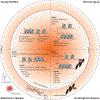Epigenetic Regulation in Neurodegenerative Diseases
- PMID: 29885742
- PMCID: PMC6174532
- DOI: 10.1016/j.tins.2018.05.005
Epigenetic Regulation in Neurodegenerative Diseases
Abstract
Mechanisms of epigenetic regulation, including DNA methylation, chromatin remodeling, and histone post-translational modifications, are involved in multiple aspects of neuronal function and development. Recent discoveries have shed light on critical functions of chromatin in the aging brain, with an emerging realization that the maintenance of a healthy brain relies heavily on epigenetic mechanisms. Here, we present recent advances, with a focus on histone modifications and the implications for several neurodegenerative diseases including Alzheimer's disease (AD), Huntington's disease (HD), and amyotrophic lateral sclerosis (ALS). We highlight common and unique epigenetic mechanisms among these situations and point to emerging therapeutic approaches.
Keywords: Alzheimer’s disease; Huntington’s disease; chromatin; epigenetics; histone modifications; neurodegenerative diseases.
Copyright © 2018. Published by Elsevier Ltd.
Figures

References
-
- Cuvier O and Fierz B (2017) Dynamic chromatin technologies: from individual molecules to epigenomic regulation in cells. Nat Rev Genet 18 (8), 457–472. - PubMed
-
- Jones PA et al. (2016) Targeting the cancer epigenome for therapy. Nat Rev Genet 17 (10), 630–41. - PubMed
-
- Bourgeron T (2015) From the genetic architecture to synaptic plasticity in autism spectrum disorder. Nat Rev Neurosci 16 (9), 551–63. - PubMed
-
- Magistretti PJ and Allaman I (2015) A cellular perspective on brain energy metabolism and functional imaging. Neuron 86 (4), 883–901. - PubMed
Publication types
MeSH terms
Substances
Grants and funding
LinkOut - more resources
Full Text Sources
Other Literature Sources
Medical
Miscellaneous

